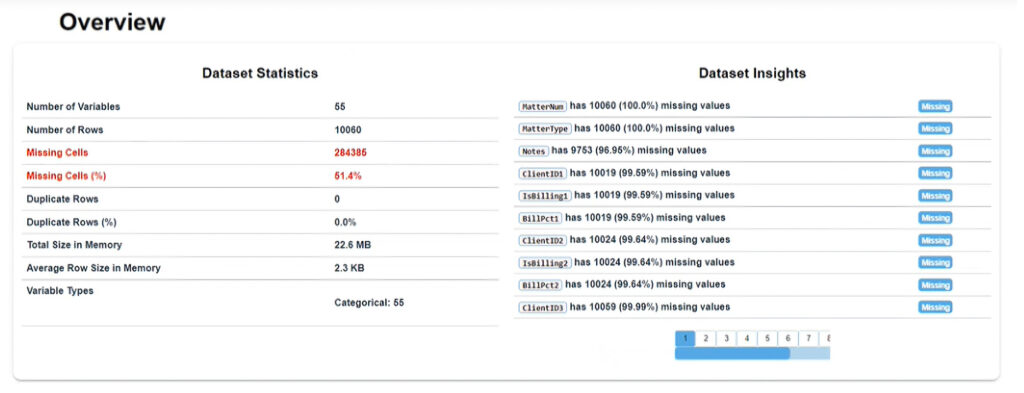Introducing Digital Eye: Redefining data quality with Helm360
Cleaning data, migrating data, converting data, really anything in the data maintenance realm is tricky. How do you find errors? How can you tell all the records are accounted for? How do you locate empty fields?
These are rudimentary questions and yet, when it comes to making important system updates and strategic technology decisions at law firms, the devil is in the data.
Does that make you sigh heavily? If your firm has undergone a data conversion, extraction, migration, or cleaning, you’re probably having flashbacks right now to the hours and hours spent going back and forth tracking down myriad issues and correcting them.
Or maybe you didn’t correct them but somehow made the situation work, and now your firm is going forward with “dirty” data. This begs the question: Is the data you’re using to make management decisions truly accurate? How will incomplete or erroneous information affect your firm long-term?
Helm360 has spent years grappling with these issues. We’re constantly asking ourselves: How can we make data discovery easier? How can we make it faster, more informative?
After many cycles of research and development, we’re happy to report that we’ve found a great solution – and it’s already benefitting law firms around the globe.
Introducing Digital Eye, Helm360’s new data discovery application that is transforming our Data Services capabilities. Take a look.
Digital Eye in a Nutshell
- Automated data discovery: Digital Eye automates the entire data discovery process and generates meaningful reports in approximately 1-2 hours.
- Detailed reporting and analysis: Digital Eye’s interactive interface pinpoints data issues and gives clear steps for correcting them.
- Easy implementation: Plug-and-play execution allows Digital Eye to work with data from any system. It can be ready to go in 5 minutes or less.
- User-friendly UX: Non-technical professionals, we’ve got your back! Digital Eye presents data clearly and concisely, making approvals and sign-offs a breeze.
Taming the Data Beast
Every data manipulation project (conversion, migration, upgrade, etc.) starts with data discovery. It’s how everyone involved gets on the same page. The discovery process also shows the tech team what they’re working with.
Typically, the results of a discovery audit are summarised in a static report or scorecard that gives a snapshot of how the data look by area. These reports answer questions like: Is each field populated and formatted properly? Do issues exist? If so, how severe are they?
Snapshot summaries like these are very good at giving readers a bird’s eye view, but they don’t provide many specifics. For example, while the tech team in charge of a migration may learn where to look for errors generally, they will inevitably need to spend many more hours tracking each error down for correction.
Data discovery reports are just the start of the data quality journey. They fall short of revealing what it actually takes to correct bad data, and they don’t usually allow firms to take a proactive glimpse into their data’s possible deficiencies quickly and easily.
The Helm360 team developed Digital Eye to go beyond the typical audit report and fill these important information gaps.
Unlike high-level snapshot reports and scoreboards, Digital Eye’s interactive dashboard gives decision-makers a clearer, more detailed understanding of their data early in the conversion/migration process. It leads data conversion teams straight to specific issues…

… and tells them how to fix them.

Armed with this deeper level of insight, firms are able to fix data quality issues in a much more sustainable, scalable way. How much time does that save on any given data conversion or migration project? A lot. (We’re still gathering accurate statistics, but our preliminary findings are HUGE.)
With significantly more information about the data at hand, give tech teams and firm leaders can quickly determine where the issues are located, what kinds of issues they are, and what corrective actions are needed. In addition to saving incredible amounts of time in data cleaning, these details enable better scheduling, budgeting and planning for the project as a whole.
Making space for decision-making
Undergoing a data extraction, migration, conversion, or upgrade is an enormous opportunity for a firm’s management to 1) get a holistic view of their system’s data and 2) consider whether the current data structure is appropriate for the firm’s future. Data projects are naturally complex, and Digital Eye helps ensure that the best window for making key decisions around data organisation isn’t missed.
When all attention is focused on a static report from the data discovery process, time and energy is often spent inefficiently. For example, teams get caught up in things like mismatching AR figures and spend hours going back and forth trying to figure out if retired timekeepers are affecting open matter records, researching issues, writing scripts, and running tests – all without ever having any thoughtful discussion about the underlying data.
Digital Eye makes space for conversation, collaboration, and considered decisions.
By delivering an in-depth view of issues early in a project, Digital Eye gives firm management the opportunity to debate which data are truly important and which are moot. For instance, if your firm doesn’t use a timekeeper final approval function, then you have no need to devote time to fixing those errors. This decision frees up time for issues that do matter and saves the firm money in the process.
Digital Eye’s easy-to-read reports also help general project communication. Non-technical participants can quickly understand its charts and graphs, which expedites approvals and sign-offs. Its user-friendly UX allow in-house and vendor teams to communicate seamlessly; everyone’s reading the same information without confusion.
The simplicity of this approach is key. Helm360 has predefined Digital Eye templates for known systems that we can easily adapt to each client’s specific circumstances, allowing us to generate meaningful output quickly and without piling on costs.

What it means for our process
Our Data Services team knows their stuff. We’re frequently called in to straighten data manipulations that have gone seriously awry. Our knowledge of the legal landscape and deep familiarity with the management applications used in the industry make us highly effective at doing this detailed work.
Adding Digital Eye to our toolbox catapults our effectiveness to a new plane! Here’s a quick rundown on how it’s improving our services:
- We get a clearer project overview, which allows for accurate planning and budgeting.
- We avoid bottlenecks as Digital Eye reports show us early on where extra work may be needed.
- We’re self-sufficient as Digital Eye eliminates the need to get verification every time we make a change; we don’t have to bother you with the small stuff.
- We can see where data health is lacking, determine how it will affect the project, and bring the data current before we start moving it to a destination system.
We considered our services top-of-the-line before Digital Eye. Now, we have an even greater ability to go well beyond expectations.
Bonus feature: Address clean-up!
One of the most common pain points of legacy data migration is the quality of address data. For example, it’s quite common to have no defined fields for City, State, Country, Zip/Postal Code, etc. Instead, there’s a simple structure consisting of address lines 1 through 6. While those open fields can be used however a firm chooses, they can also create a maintenance nightmare and hinder automated workflows that rely on this data being accurate.
Common problems we see with address data are:
- Duplicate addresses (the bane of many CRMs!)
- Slight variations on the same address due to a typo or specific recipient on the first address line
- Partially populated address data (missing vital elements)
- Inconsistent cities, states etc. (e.g., “Pennsylvania” versus “PA”)
How does Digital Eye help?
Digital Eye allows us to analyse large volumes of messy address data and quickly make sense of it. It’s a three-step process:
- We leverage a tried and tested parsing/normalisation library that uses machine learning to compare the data to tens of millions of real-world addresses. The result is a highly accurate report showing us what’s missing.
- We use NLP (natural language processing) to interpret address strings efficiently and accurately.
- We combine machine learning with human interpretation to build a de-duplication model that allows highly accurate classification of duplicate addresses.
All this occurs super-fast and without any address data leaving your network. It completely negates the need for a pay-per-use API validation.
Conclusion
We’re super excited about Digital Eye. We’re already working on improvements that give it even more functionality and usability. For now, we can’t wait to put it to work for our Data Services clients. If one of these projects is on your horizon, give us a call. We’d love to put Digital Eye to work for you.
We’d love to show you Digital Eye in person. Contact us for more information and a free demo. Or connect with our Sales Team and schedule your data services project now.



